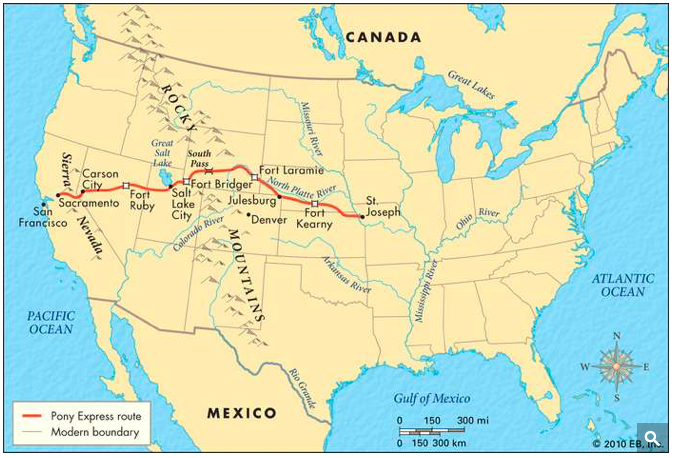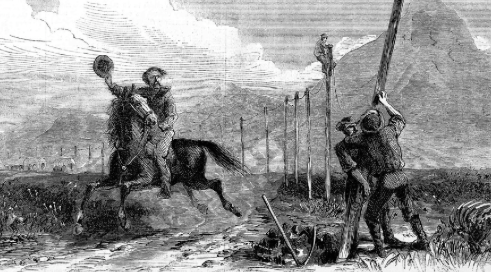On the fourth of April, 1860 the stagecoach lines were completely snowed in across the Sierra Nevada range. A lone horseman bent low on his mount pushed eastward through the blinding blizzard. Occasionally the rider had to dismount to break a path through the deep drifts. As the day progressed the horse and rider began to descend the east slope of the range and eventually they had easier travel. At nightfall they followed a trail through a densely forested canyon until at last the rider saw lights of a town and the station ahead. Stiff and cold to the bone, the rider quickly dismounted and the station operator had a fresh horse saddled and standing by. The rider mounted with his mochila of mail and galloped toward the next station fourteen miles farther east where a new horse and different rider were waiting. The operator transferred the mochila and the new rider took off in to the night.
This description is an imaginary account of the first eastbound Pony Express rider crossing the mountains on his way from Sacramento, California to Carson City, Nevada. The mail left Sacramento at 2 A.M. on the fourth, passed through Salt Lake City just before midnight on the seventh, and arrived in St. Joseph, Missouri at 4 P.M. on the thirteenth. The mail continued by train and four days later arrived in New York City. The nation stood in awe that mail had travel across the continent in only fourteen days, and only ten days across the “Great American Desert.”
The men who worked the California gold fields lived in isolation from the rest of the country. Despite their rough existence of hard work, booze, and women, they still hoped to get rich and return home. They demanded overland mail service with the Midwest. The first effort was a forerunner of the Pony Express. In April of 1851 the U.S. government made a contract with two men, George Chorpenning and Absolam Woodward to carry mail once a month by horse and rider between Sacramento and Salt Lake City through Nevada along the Humboldt River. This 900 mile route, initially called the “jackass mail,” began in May 1851 and took sixteen days, and much of the time involved clearing a way through snow in the Sierras. Crossing the Sierras and following the Humboldt in winter proved such a time-consuming hardship that they began using that direct route only in the summer and changing to the Southern Route during the winter. The Southern Route followed the Butterfield Stage Route through Arizona. After four years customers demanded a return to the much shorter and faster Sierra Nevada route. Even in summer, crossing Nevada was fraught with danger and hardship from poor grass, poor water, and “an inhospitable and poisoned waste.”
In 1855 Congress began to feel pressure to institute a more frequent mail service to California. The contract went to three private operators, William Russell, Alexander Majors, and William B. Waddell, three men who knew their way through government channels. They soon began the enterprise that became the Pony Express. The concept was not new. Relay systems of couriers had been used in ancient Persia and in the empire of Genghis Khan. What distinguished the Pony Express was not the novelty but the efficiency and brilliant execution. The very image of the brave riders speeding through dark and storm and danger to make a fast, weekly mail service immediately captured American hearts.
During the winter of 1859-60 the newly formed company established stations at 10 to 12 mile intervals along the 1,424 miles between Sacramento, California and St. Joseph, Missouri. Between Sacramento and Salt Lake City, Utah they had to build new stations. Eastward from Salt Lake City the company often used existing businesses willing to become stations. Before the first riders started riding, the company had invested about $100,000 ($3.1 million today) in the new venture. They bought five hundred of the best horses and manned 190 stations. Wherever possible the stations were constructed near military forts for added protection. Fort Kearny, Nebraska, Fort Laramie, Fort Casper, and Fort Bridger, Wyoming and Fort Bowie, Arizona are a few examples of forts near the Pony Express route.
There were two-hundred station tenders to care for the horses and eighty seasoned riders for runs of seventy-five to one-hundred miles a day. The plan was to dispatch mail between Sacramento and St. Joseph once a week.
Each rider had a route of 80 to 100 miles on which to travel back and forth. While traveling his route a rider would change horses eight to ten times during the six to eight hour ride. At the end of his route he passed the mochila to a fresh rider who would then traverse the next segment of the route. The first rider would wait at the station for the next rider traveling in the opposite direction, then transfer the mochila (see illustration) to a fresh horse and return to the beginning of his route. The horses usually traveled at a trot or canter at 10 to 15 miles per hour, but at times they were pushed to gallop up to 25 miles per hour.
The initial charge for letters was $5 ($155 today) per half ounce. With such a high price the customers were mainly governments, banks, and businesses. Letters were written on tissue paper with no envelopes, to lighten the load. The company soon found that the number of customers was too low to sustain a business that was in the red from the first day. Russell, Majors, and Waddell had hoped to establish the feasibility of such a year-round courier service, and that Congress would be persuaded to subsidize a daily Pony Express service, but that never came to pass.
The Pony Express service came at a high price for the riders crossing the “Great Desert.” Besides the risk of crossing arid land there was hostility among the Paiutes, the Washoes, and the Shoshoni tribes over the intrusion into their lands. Some riders were attacked, as were relay stations. Often a rider arrived at a station only to find it in flames. With all this excitement they received high compensation—up to $125 ($3800 today) per month, very good pay for the time—unskilled laborers about $1.00 per day. Replacement of burned relay stations cost the company $75,000 ($2.3 million today). Despite all this danger only one rider is known to have been killed by raiding tribesmen. Also, reports show that two men froze to death.
It was the threat of hostile native attacks and the split-second schedules that gave the Pony Express such a revered image in the American mind. It was clearly an unsustainable operation financially and only by its romantic image could such a short lived venture still resonate today. The Pony Express had one great moment in 1861 when riders traversed the westward route in a record seven days and seventeen hours to bring a copy of Lincoln's inaugural address to California. The Pony Express was by far the most effective way to communicate cross-country at the time.
After eighteen months Russell, Majors, and Waddell recognized that the Pony Express was not going to be subsidized by the government. Their expenses are estimated to have been about $500,000 greater than income. It was not, however, just the financial ruin that killed the Pony Express. The end was made inevitable by the construction of lines by the Overland Telegraph Company, which merged with another telegraph company and changed its name to Western Union.
The Pony Express played an oversized role in the popular imagination, considering its brief existence. Launched in April, 1860 it operated for eighteen months before the first trans-continental telegraph line was completed. The Pony Express officially shuttered on October 26, 1861.
Sources
Morgan, Dale L. The Humboldt: Highroad of the West. Lincoln: University of
Nebraska Press.1943.
wikipedia.org/wiki/George Chorpenning
wikipedia.org/wiki/Pony Express
history.com/news/10-things-you-may-not-know-about-the-pony-express
mentalfloss.com/article/537885/facts-about-pony-express


 RSS Feed
RSS Feed
